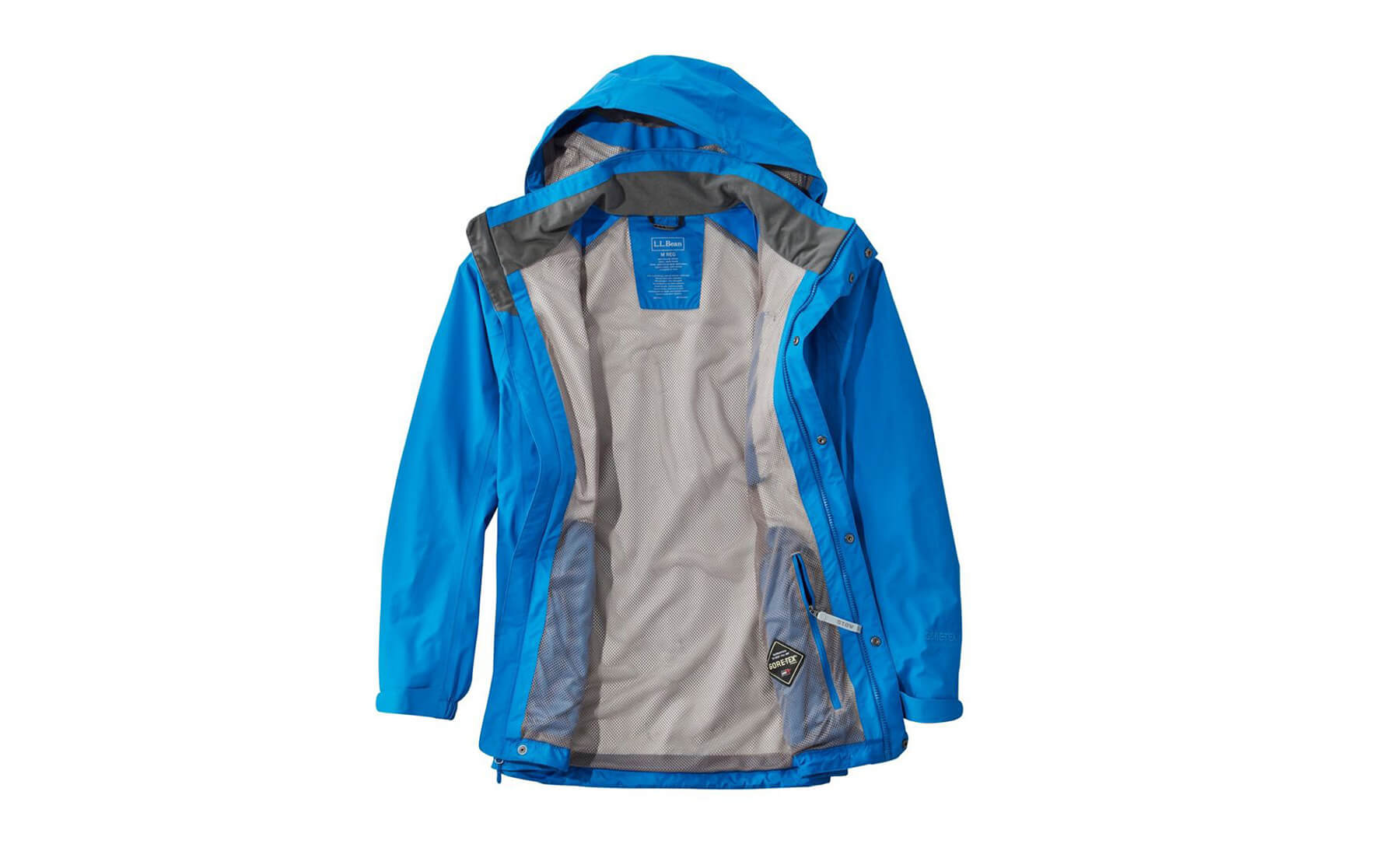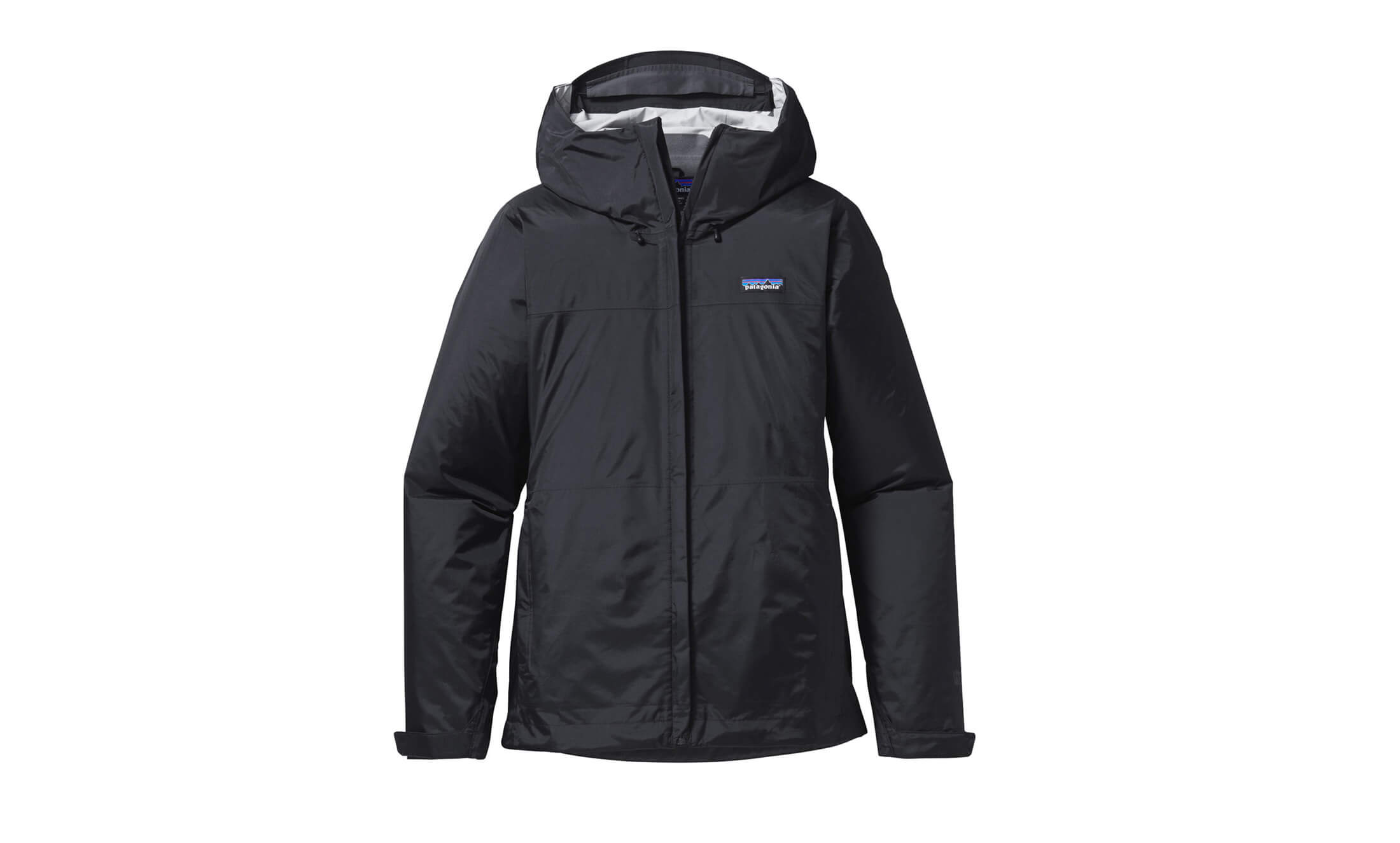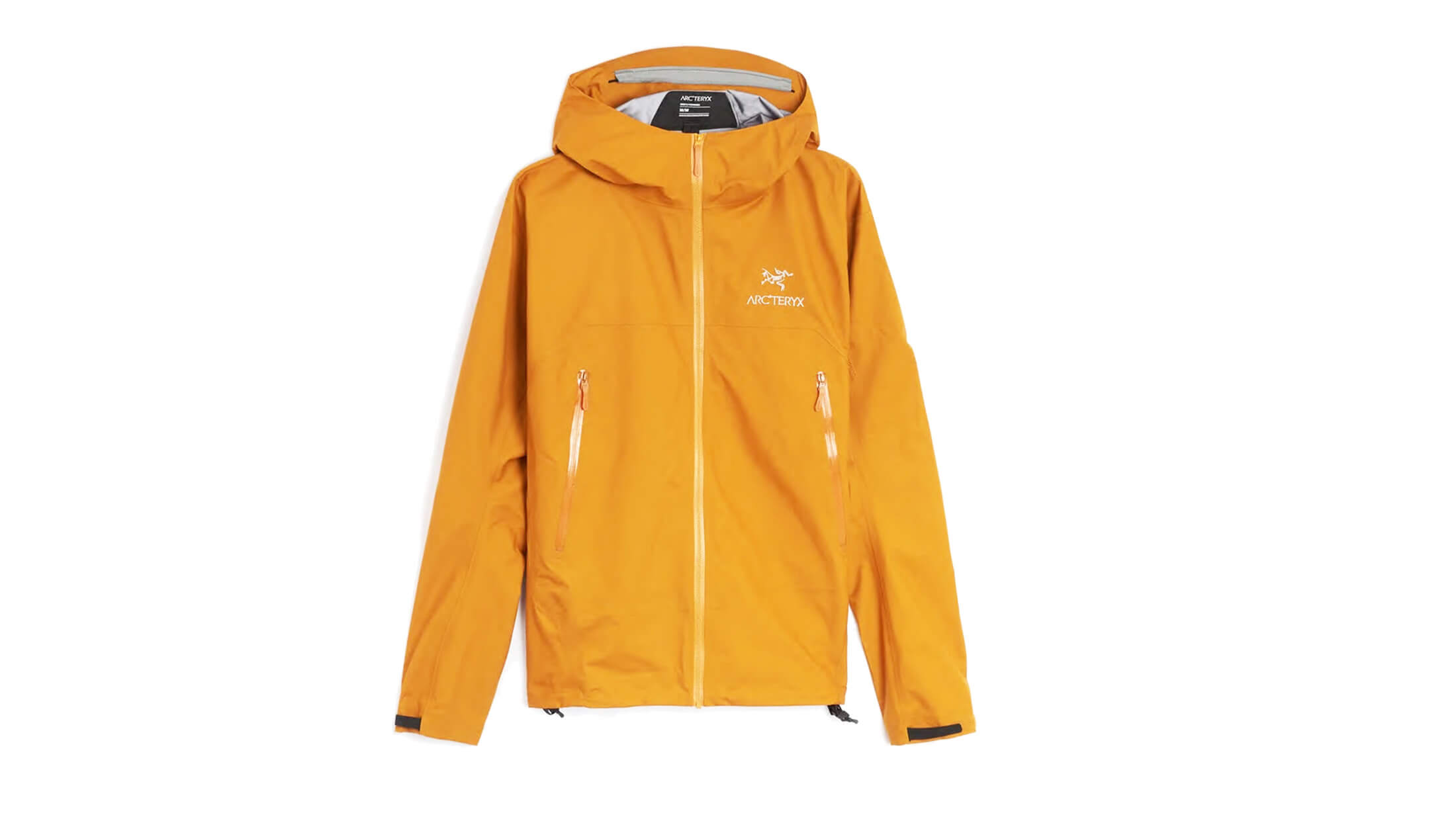A good rain jacket is one the most important pieces of clothing in an outdoorsman’s wardrobe. It doesn’t matter if you’re into backpacking, climbing, running or mountain biking – you need a waterproof layer to keep the rain off you when the skies open. However, what you need from a shell can change depending on your preferred type of activity, priorities, and budget. In this article, I look at how these factors and other considerations can help you make an informed decision when you buy your next piece of rainwear.
Note: This is just one article in a whole series on how to choose rainwear and outer layers.Other articles include how to layer outdoor clothing and how to choose between a rain jacket and a poncho. Both are well worth a read if you’re relatively new to the whole outdoor thing and are still trying to figure out what a budding outdoorsman needs in his or her wardrobe.
- Waterproof vs water-resistant
- 2L, 2.5L and 3L fabrics
- Waterproof-breathable membranes
- Rain jacket features
- Types of rain jacket
- Factors affecting rainwear choice
Waterproof vs water-resistant
When choosing an outdoor jacket, it’s important to know the difference between the three levels of water resistance.
Water-resistant
‘Water-resistant’ means that a fabric is tightly woven or manufactured in such a way as to resist penetration by moisture. But that doesn’t mean much. A garment made from water-resistant fabric won’t keep you dry in much more than a misty morning fog or a little drizzle. This is the lowest level of protection against moisture.
Water-repellent
Water-repellent fabrics have one up on water-resistant fabrics in that they have a durable water repellent (DWR) coating which causes water to bead and roll off a jacket instead of soaking through it. This slows the speed at which a jacket becomes saturated in sustained rain. Because they don’t have waterproof membranes, water-repellent fabrics are only good for keeping you dry in light rain and are not sufficient for rainwear.
Waterproof
A waterproof layer will keep you dry even in hard or sustained rain. Garments deemed waterproof typically have a DWR-treated face fabric and a waterproof-breathable membrane. Beyond this, they also need to have sealed seams (taped or heat welded) to ensure that water doesn’t get through the seams. All jackets that are intended to be used as rainwear should be ‘waterproof’.
2L, 2.5L and 3L fabrics
To help you stay dry, a fabric has to be both waterproof and breathable (allow water vapor to escape). If it isn’t breathable, perspiration will build up on the inside of the garment, and you will still feel damp. While 2-layer, 2.5-layer, and 3-layer fabrics are all waterproof, they differ in terms of breathability and durability.
3L fabrics
3-layer fabrics feature an waterproof-breathable membrane sandwiched between a DWR-treated face fabric and a protective inner lining. The purpose of this last layer is to prevent sweat and oils from clogging the microscopic holes in the waterproof-breathable membrane – something that would hinder breathability and make the wearer clammy with perspiration. It is this resistance to fouling that gives 3-layer fabrics an advantage over 2-layer and 2.5 layer fabrics. The disadvantage of 3L fabrics is that they are slightly heavier than fabrics with fewer layers. As with 2L and 2.5L fabrics, the degree to which a 3L fabric is breathable depends on the thickness of the face fabric and the type of membrane.
2.5L fabrics
Although lighter, fabrics with a 2.5-layer construction look similar to 3-layer fabrics. They have the same DWR-treated face fabric and a waterproof-breathable membrane. But instead of having a protective lining bonded to the inside of the membrane, 2.5L fabrics have only a protective coating (the 0.5 layer). Although this kind coating does a good job of protecting a membrane, it generally does not do as good a job of absorbing and transmitting perspiration, and can leave the wearer feeling a bit clammy if the jacket is worn next to skin. Recent developments in 2.5L fabric construction have helped improve the clammy factor, and some are now almost as comfortable as 3L fabrics.
2L fabrics
Traditionally, 2-layer jackets have had DWR face fabric bonded to a breathable-waterproof membrane with a loose (typically mesh) protective liner hanging inside it. Although more affordable, these mesh-lined 2L shells are generally heavier, bulkier, and less comfortable than 2.5L and 3L jackets. Wanting to come up with a lighter alternative to 2L and 2.5L fabrics, Gore-Tex has developed Paclite Plus, a 2L fabric that uses a textured membrane to add a level of abrasion resistance and make it unnecessary to use a mesh liner or protective coating. While this does make Paclite Plus very light, it also makes it less durable than other 2L and 2.5L fabrics, meaning that it’s best reserved for applications where light weight takes priority of every other consideration.
Waterproof-breathable membranes
Making a garment waterproof isn’t difficult, but making it waterproof and breathable is. To overcome this challenge, gear manufacturers have all turned to the same solution, a waterproof-breathable membrane. The original ePTFE membrane was produced by Gore-Tex, a brand that dominated the market for decades. But today there are many other types of waterproof-breathable membrane including several that are PFAS-free and much better for the environment. To learn more about these different membranes and the PFAS-free trend, see my guide to waterproof-breathable fabrics. Otherwise, you can find the short version below.
Waterproof breathable membranes work in one of two ways. Air permeable membranes (ePTFE and electrospun polyurethane) are porous and allow for air to pass through them while preventing the transmission of water droplets. Vapor permeable membranes (ePTFE-PU, polyurethane films, and polyester), on the other hand, are non-porous and allow for only water vapor to pass through them. Given that air can’t pass through them, Vapor permeable membranes are inherently less breathable than air permeable membranes. There are, of course, also upsides to monolithic polyurethane and polyester membranes, so you shouldn’t immediately rule them out.
Jacket features
Besides the type of fabric, there are several features worth considering when choosing a new rain jacket.
Face fabric
As the outermost layer in a jacket, this material determines a garments’s look, feel and durability. The thicker and heavier the face fabric, the more durable it is likely to be. Besides providing the first line of defense against the elements, the face fabric also protects the waterproof membrane, which is why it is important that it can stand up to the expected level of wear.
DWR coating
The face fabric on all rain jackets is treated with a durable water repellent (DWR). This hydrophobic coating encourages water to bead off the fabric rather than be absorbed by it. Besides providing a first line of defense against moisture, this beading function is essential for preserving a membrane’s breathability. The less water that makes it past the face fabric and DWR, the better a membrane can breathe. A saturated or ‘wetted out’ garment, on the other hand, won’t breathe at all, resulting in a build up of perspiration – and that clammy feeling.
Taped seams
The weakness in sewn waterproof garments are their seams. When the different pieces of material are sewn together, the needle creates tiny holes in the membrane where water can pass through. To prevent this, most manufacturers seal the seams on their jackets with tape. The downside to this approach is that tape eventually perishes and then needs replacing after several years. This is why some brands now weld the seams on their jackets shut. If this solution proves effective, other companies will likely start doing the same.

Inner lining
Most 2L jackets have a third, loose layer (usually mesh) on the inside of the garment. This provides additional protection for the membrane – preventing it from being contaminated with the oils on your skin – and improves next-to-skin comfort. The downsides to this lining is that it makes a jacket heavier and more bulky than equivalent 2.5L and 3L jackets, which have a coating or thin layer bonded to the membrane in place of a separate lining. For this reason, you're more likely to find inner linings in budget-end jackets.
Hood
A hood is essential on any rain jacket, but the size and shape of the hood can also be important depending on what you’re going to use the jacket for. If the jacket is going to be used for climbing or mountain biking, you will need to make sure that the hood fits over a helmet. Beyond this consideration, a hood should keep its shape in a strong wind. Without a sufficiently stiff brim, it could fold flat against your forehead, which would do nothing to protect your face from rain and runoff.
Pit zips
When you’re working hard, the amount that you sweat can easily exceed the breathability of a membrane, and that’s why many rain jackets have zippered vents under the arms to help with air flow. These are a must on any fully featured jacket, especially one that you will use for hiking or other high output activities. Some jackets also have a mesh liner behind torso pockets, which can then also double as vents.
Pockets
Most people will want a couple of pockets to stash things like snacks, sunscreen, or a device in. If you are going to wear the jacket while hiking or climbing, look for a jacket that has pockets higher up on the chest. That way you can still be able to get into them when you’re wearing a hip belt or harness. For runners and mountain bikers, a pocket at the back and above your bum can be very useful for storing a cellphone or car key.
Types of rain jacket
Waterproof jackets typically fall into one of two broad categories: hard shells and rain shells (also called ‘rain jackets’). Hard shells with their 3-layer construction are generally more expensive, heavier, and offer a greater degree of weatherproofness, while 2-layer and 2.5-layer rain shells are lighter, more affordable and sometimes less weatherproof. I say ‘generally’ because in recent years, this distinction has become somewhat blurred with some 2.5L shells offering as much protection and comfort as some hard shells and some 3L shells being marketed as rain jackets. In many instances, it’s best to look at a jacket’s specs to get a proper idea of what it's about. For example, even though the Patagonia Torrentshell, with its 3-layer construction and 50D ripstop nylon face, is described as a rain jacket, it can definitely be considered a hard shell.
Hard shells
For maximum durability and protection in extreme weather, there’s no better type of outer layer than a hard shell. Almost all hard shells are made with some kind of 3-layer fabric that sandwiches a waterproof-breathable membrane between a durable outer layer and a protective inner lining. Gore-Tex (Pro or Performance) is the most popular choice here, but at least a dozen brands use eVent or NeoShell. Most hard shells have features like hand pockets and pit zips, but some don’t. It all depends on their intended use.

Alpine hard shells
Designed to protect climbers from the kinds of extreme conditions experienced in the high mountains, alpine shells are the most burly and fully featured type of hard shell. It also only makes sense that all jackets in this category have waterproof zippers, helmet-compatible hoods and pockets positioned to be clear of a harness or waist belt. Of course all this comes at a cost, and alpine shells are the heaviest (18oz / 500g) and most expensive type of jacket.
All-round hard shells
Striking a balance between weight and functionality, all-around hardshells are designed to excel in a range of conditions. This versatility makes all-round hard shells the best choice for hiking and backpacking when there is rain in the forecast. Because these are the most common type of hardshell, they also range the most widely in price with some being significantly less expensive than others.The average all-round shell weighs somewhere between 13 and 16oz (370 - 450g).
Lightweight hard shells
When space and weight are a big consideration – as they often are in ultralight backpacking and climbing – a lightweight hard shell can satisfy your priorities while sacrificing some functionality. While still using a 3L construction like other hard shells, these jackets are made from thinner fabrics and are often missing features (i.e. pockets and pit zips) found on fully-featured shells. The lightest hard shells weigh around 9 oz (250g).
Rain shells
Rain shells differ from hard shells in that they are made from 2L and 2.5L fabrics instead of the 3L fabrics. This makes rain shells less breathable and less durable than hardshells - although performance can vary widely depending on the intended use of a jacket. On the plus side, rain shells are generally less expensive than hard shells and can be made lighter than hard shells.

Performance rain shells
Comparable to lightweight 3L shells, performance rain shells are more breathable and more functional than other rain shells. They are almost always made from a 2.5L fabric to save weight (using a coating to protect the membrane instead of a loose mesh lining) and generally have more durable face fabrics, waterproof zippers and hoods that offer better coverage. Most jackets made from Gore-Tex Paclite fall into this category. Average weight: 8 to 13oz ( 225 - 370g)
General rain shells
Like more performance-orientated shells, general purpose rain shells have most of the features you expect to find on a rain jacket, including pit zips, pockets, and cuff adjustments. But they are typically made from less expensive materials with some more budget-friendly jackets using 2L fabrics instead of the 2.5L fabrics used in mid to high end jackets. Again, 2L rain shells have a mesh liner, which makes them a little heavier – up to 3oz (85g) heavier than equivalent 2.5L shells, which typically top out at 13oz (370g).
Ultralight rain shells
Made from the thinnest 2.5L fabrics and missing many of the features found on other jackets, these ultralight shells can fit into a stuff sack no bigger than a potato. The tradeoff, of course, is that these stripped down minimalists don’t perform as well as jackets. Their fabrics tend to wet out and stop breathing more easily, and without pit zips, the only way to improve ventilation is to pull down the chest zip. But many consider these to be sacrifices worth making when every ounce matters. The lightest of these weigh a little over 6oz (170g).
Factors affecting rainwear choice
If you are still not sure what kind of jacket will serve you best, consider the following factors.
Weatherproofness
All rain jackets are ‘waterproof’ as opposed to merely ‘water-resistant’. But not all waterproof jackets are equal. With their typically thinner face fabrics, rain shells will sometimes allow some moisture in when subjected to sustained and heavy rain. Hard shells, on the other hand, are completely impermeable, and, with their more substantial hoods and hems, will keep you dry in even the wettest conditions. The most reliable way to gauge the waterproofness of a shell without actually testing it is to look at its waterproof test rating. A jacket rated to 5,000mm is just barely waterproof, while a shell rated to 20,000mm will hold up to the worst conditions.
Breathability and ventilation
While the thicker fabrics used in hard shells are initially less breathable than the materials used in rain shells, 3L hard shells are less likely to wet out and become even less breathable in sustained rain, which again means they perform better than rain shells in very wet conditions. However, many rain shells also have pit zips and ventilated chest pockets – an equally important factor when determining how well a jacket will breathe and ventilate. If breathability is a priority for you, look for these features while also considering how a jacket’s fabric will affect breathability in different conditions.
Comfort
There are two things that affect how comfortable a rain jacket is. The first is next-to-skin feel. Hard shells with their 3L fabrics have a softer layer on the inside of the jacket, making them more comfortable to wear over bare arms. 2.5L rain shells on the other hand have a plasticy feeling to them. The mesh linings on the inside of 2L shells feel better, but then you are incurring a significant weight penalty. The second factor is stretchiness. Jackets that have a little stretch in them are less restrictive and therefore more comfortable. While rain jackets are inherently less stretchy than soft shells, some do have a little elasticity in them.

Durability
When it comes to durability, it’s not much of a contest. Hardshells, with their thicker face fabrics, are significantly more durable than rain shells. If you are going to wear a jacket day after day and expose it to the abrasive forces of rock, a hard shell is a better option as it will last longer than a rain shell. That said, not all hard shells are equals, and the same goes for rain shells. High-end jackets in both categories are typically made with more durable fabrics that will stand up better to the wear and tear of regular use. Of course, how you look after your jacket will also affect its longevity, but more about that in a minute.
Weight and packability
Given their thinner fabrics and more stripped-down designs, rain shells generally weigh less and pack down smaller than hard shells. Granted, there will be some exceptions. A 2L rain shell can easily weigh more than a lightweight hard shell. But then we aren’t apples with apples. If we were to compare two jackets in the same price range, a 2.5L shell would almost certainly be heavier than an equivalent hard shell. Should this be factored into your purchase decision? Only if weight is more important than performance, comfort and durability (runners and ultralight backpackers will happily make such compromises).
Cost
Besides weight, this is the one area in which rain shells usually beat hard shells: they’re just less expensive. Whereas hard shells range in price from $200 to $600, budget end rain shells cost as little as $75 with more high-end models costing between $150 and $300. This works out to a difference of over a hundred dollars for reliable protection.
How to care for your rain jacket
A waterproof jacket will keep you dry and warm for many years if properly cared for. Here’s how you get the most out of it.
Wash your rain gear regularly
With use, a garment will be exposed to dirt, sweat, sunscreen and insect repellent, all of which can reduce the effectiveness of a DWR application. Fortunately, restoring the breathability of a garment can be as easy as washing it. Use a suitable soap like Nikwax Tech Wash and make sure to read the manufacturer's washing instructions on the label. Most jackets can be machine washed, but you should always check first.
Don’t use fabric softener
Fabric softeners and bleach can damage the membrane in a waterproof jacket, so you should keep these products away from your rain wear. This actually applies to most technical clothing, which is just another reason that it’s best to wash your synthetic outdoor clothes (all of which should be washed with tech wash) in a separate load if possible.
Reapply DWR when needed
After a while, your jacket’s DWR will become noticeably ineffective even after you wash it. Instead of beading up on the surface, water will permeate the face fabric, causing the garment to ‘wet out’ and stop breathing. This is a sign that it is time to reapply DWR. But this is quite easy. With waterproof jackets, you wash in the DWR, using a product like Nikwax TX Direct. Again, read the label so that you know how to wash and dry the garment without damaging it.
Get more advice from this gearhead
You now have everything you need to know about rain jackets. But don’t stop here. On this website you’ll find many more articles on everything from how to layer outdoor clothing to how to sleep comfortably on the trail. Do some exploring, and you’re bound to discover some tips and tricks to help you make the most of your next adventure. Alternatively, sign up for my newsletter and get all the latest from Trail & Crag delivered straight to your inbox.
